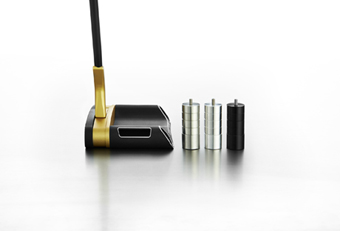
Putting: The game in the game
Putting has so many peculiarities and unique aspects that it is often seen as an independent “game in the game”. It is only in recent years that this aspect of the game of golf has been scientifically studied in more detail. Measurements sometimes brought surprising results to light, which we take into account when building our EasyPutter.
Most used clubs
and therefore the most important club is the putter. About half of our golf swings are made with the putter.
A 10cm putt is just as important as a 230 meter drive – if it doesn’t work, it costs one point.
The fastest and easiest way to improve your score – improve your putting skills
No other stroke in golf can be improved as easily, quickly and permanently as putting – regardless of age, constitution, condition and handicap.

Why is putting so difficult for many golfers?
Aim:
Measurements on many hundreds of golfers have shown that over half of the golfers already MISS the hole from a distance of 2.5 meters. The unusual position of bending over the putter to aim at a target is not only difficult, but for many golfers it is physiologically impossible to do so precisely. (Deepening: parallax error, corneal curvature). Remedy: Aim as with a rifle, eyes in line with “notch”, “bead sight” and aim – namely BEHIND the putter.
Direction control:
The clubface has the greatest influence on the correct direction.
If it is not 90 degrees (square) to the aiming direction at the moment of impact, the ball rolls in a different direction.
If the swing path on which the club head moves at impact is not identical to the aiming direction, the ball will not roll in the desired direction, but the effect is significantly less in percentage terms than with a twisted clubface.
Putter head square at the moment of impact is much more important than the absolutely correct swing path!
The correct clubface (square = 90 degrees to the target line) is much more important than the swing path – the twisted clubface causes almost 80% deviation (example: clubface 10 degrees open, ball rolls about 8 degrees sideways)
A deviation from the ideal swing path has an effect of approx. 20% deviation.
If the club head hits the ball on a 10% trajectory to the target line with a squared clubface, the deviation is only about 2 degrees.
Deviations are a factor of almost 1 to 4, so it is much more important to concentrate on a square clubface than on the swing path.
Green speed:
Due to the different characteristics of the green (hardness, dryness, grass type and cut length), balls can roll very differently for the same swing. These conditions can change from course to course and even on a course from day to day.
The identical swing can make the ball roll from
- 80 meters (slow green)
- to 5 meters (very fast green for club level)
- 7 meters (very fast PGA greens)
These differences of more than twice the rolling distance (with the same energy absorption) make it very difficult to achieve reliable length control solely from feeling. Here will help precise reference points – keyword: length calibration – see also tips and tricks – length control.
Breaks:
Reading breaks is important – and unfortunately not very easy. But you can make it easier for yourself by using modern methods, e.g. also the AimPoint green reading.
Our recommendations:
Analyze green already when approaching: What is the environment of the green? If the entire area around the green has a slope – then it is very likely that the green as a whole is also inclined in the same direction.
View green from at least two sides
AimPoint Express: based on the inclination of the green, which can be felt with the feet according to the instructions (advantage: no optical illusions), you can easily and quickly determine the aiming point for the putt.
Link: Aimpoint Rolf Kinkel

Different putting techniques
Different putting techniques – same force or same time
Version “same force”: here the player always moves the putter with the same amount of power – thus a short putt lasts significantly less time than a long putt – the speed of the putter head is only slightly higher on a long putt.
Version “same time”: with this putting technique exactly the same amount of time is spent on EVERY putt. In other words, a short putt is moved very slowly, a long putt must of course be accelerated much faster in the same time unit.
As a rule of thumb:
Backswing lasts as long as the complete follow through:
from middle length: 1/3 backswing, 2/3 follow through.
A song with e.g. 100 bpm (beats per minute) can be used as time unit.
This method has three advantages:
- exact time measurement, e.g. by “proverb” (e.g. “one thousand and three”) or song (100 bpm, e.g. “Hello” by Beatles)
- Exponential increase in length dosage for short putts (less swing distance AND less acceleration)
- longer putts (more than 20m) do not require as long backstrokes as with version “same force”.
More weight on faster greens – or on slower ones? Or is both correct???
Surprisingly, both are correct here – it depends on the particular type of putting.
Putt version: “same force”
For this type of putting, the following applies: slow greens = more weight (because this additional weight cannot be accelerated as quickly with the same amount of force)
Slow green = more weight
Fast green = less weight
Putt version: “same time”:
For this type of putting, applies:
Slow green = less weight
Fast green = more weight

Myths and misunderstandings
Myth: straight or circular? – the truth: the natural swing path is an ellipse segment
Golfers often argue whether the ideal technique for putting is a circular segment (open-square-open) or straight (square-square).
Here we are dealing with a major misunderstanding that could only arise because a three-dimensional movement was reduced to two dimensions:
Let’s imagine a golfer in his address position when putting.
Let’s now think of the plane of rotation (spine at shoulder level) and perform a complete circle in this movement. (Please only in thought). Depending on how the golfer stands, this will result in a more or less inclined circle, the steeper he stands, the flatter this circle will become.
Let’s change the perspective: look at the circle from above. If we project the circle onto the ground level, we get an ellipse: the steeper the golfer stands, the greater the angle of the circle that his putter head passes through when putting. The golfer, whose spine is in extreme cases horizontally aligned, has hardly any angular change of his putter head. As a result, the chance that his putter head is really square at the moment of impact is of course significantly higher.
Due to the regulations for permissible putters (especially the prescribed lie of less than 80 degrees) and the physiognomy of the person, putting in one line (on the ground) is not possible – not even with a pendulum movement. The normal putting movement, i.e. without any attempt to deliberately manipulate the club into a straight movement, will take place on a straight PLANE – this is felt to be a straight swing – but on a swing PLANE and not on a straight LINE. The putter head moves on a circular segment. Attempts to move it on a “straight line” require a permanent readjustment of the entire movement. This overtaxes the perception, processing and correction instructions in the brain and the permanent muscular readjustment – permanent attempts with this technique often produce the feared yips.
Conclusion:
The more horizontally the swing axis (spine at shoulder level) is held during putting, the higher the probability that the putter head is square to the ball at the moment of impact. (This is the most important aspect with the biggest effect on the rolling direction – see above).
Recommendation:
- A stand bent further forward is better than an upright stand.
- Do not attempt to move the putter head along a line on the ground (alignment stick etc) – permit an elliptical segment as a natural movement.
Myth: Feeling of a putter
Many golfers experience differences in the “touch” or “feel” of different clubfaces at the moment of impact. They attribute this sensation to different hardness, surface structure (keyword: grooves) and materials of the clubface.
Fact is: the clubfaces have to be very hard for approval reasons, there is no significant difference – the sensation is actually created mainly by psychoacoustic processes in the brain – we hear different sound patterns at the moment of impact and our brain suggests different “feelings” at the moment of impact.
Our tip:
Don’t be distracted by your ears, use objective data to decide which putter gives you the best results instead of falling for acoustic illusions. Give importance to aiming accuracy (keyword stability) and repeatability of the energy transfer – and this depends on the quality of the clubface. EasyPutter has therefore decided to use metal club faces instead of soft “plastic inserts”.
Myth: All putters are good enough
At first glance, this may seem to be the case to a layman – after all, it is “only” about getting a little ball rolling. Due to the importance (a putt over centimeters is just as important as a 250 meter drive) and the complexity of the repeatable, fine-tuned putt movement, a really well-fitting putter must be used for the best results. Even the pros on the PGA Tour practice putting for hours every week – if you don’t have that much time to practice, the right hardware is even more important.
The fact is:
Most experts are unanimous in their opinion that
- almost all golfers play putters that are too long (35″ is the standard length on the shelves – the average length of putters used by PGA professionals is around 33″)
- most golfers get a calmer swing with heavier putters – the small, nervous muscles in the hand and wrist are taken out of play, the movement is more from shoulder rotation
- many golfers (according to measurements approx. 50%) cannot aim correctly from the usual perspective (bent over the putter, eyes OVER the target line). They miss the hole from about 2.5 meters. An ergonomic version of aiming helps here: behind the putter, like a rifle, with the eyes in a line of aiming point – ball – putter – eyes. This is achieved with the self-standing EasyPutter, which can stand independently on the green.

